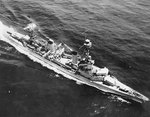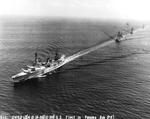Salt Lake City
| Country | United States |
| Ship Class | Pensacola-Class Heavy Cruiser |
| Builder | American Brown Boveri Electric Corporation, Camden, New Jersey, United States |
| Laid Down Date | 9 Jun 1927 |
| Launch Date | 23 Jan 1929 |
| Commission Date | 11 Dec 1929 |
| Decommission Date | 29 Aug 1947 |
| Displacement | 10,826 tons standard |
| Length | 586 feet |
| Beam | 65 feet |
| Draft | 17 feet |
| Speed | 32 knots |
| Crew | 612 |
| Armament | 10x8in, 4x5in, 2x3pdr, 6x21in torpedo tubes |
| Aircraft | 4 |
Contributor: C. Peter Chen
ww2dbaseSalt Lake City was commissioned to Captain F. L. Oliver at Philadelphia Navy Yard in Pennsylvania, United States, and departed five weeks later for her shakedown cruise off Maine in northeastern United States. In Feb and Mar 1930, she visited ports in the Caribbean Sea and Brazil. On 31 Mar, she joined Cruiser Division 2, then on 12 Sep Cruiser Division 5, of the Scouting Force and patrolled off the east coast of the United States. In 1932, she was reassigned to the Pacific Fleet, patrolling the west coast of the United States and Hawaii until 1938, with the only exception being when she was undergoing overhaul between Oct 1933 and Jan 1934, when she sailed to New York for the Fleet Review between May and Dec 1934, and when she participated in anti-submarine practice off Panama in Apr 1936. Beginning on 13 Jan 1939, she visited ports in the Caribbean Sea, the Central Pacific, and Australia.
ww2dbaseWhen the Japanese struck Pearl Harbor in Dec 1941, Salt Lake City was escorting carrier Enterprise between Wake Island and Pearl Harbor. The task group launched aircraft in search of Japanese carriers, but failed to locate them. The task group made port call at Pearl Harbor in the evening of 8 Dec. In the morning of 9 Dec, the task group set sail to make contact with Japanese submarines to the north, returning on 15 Dec. After patrolling off Hawaiian waters, she was a part of the effort to relieve Wake Island that was eventually called off. In early 1942, she escorted carriers as the aircraft struck Japanese bases in the Marshall Islands and at Marcus Island. In Apr, she escorted carriers Hornet and Enterprise on the Doolittle Raid. In May, she sailed for Coral Sea, but arrived after the battle had already taken place. During the Midway battle, she provided rear guard protection for the rest of the Hawaiian Islands chain.
ww2dbaseBetween Aug and Oct 1942, Salt Lake City supported the Guadalcanal Campaign by escorting carriers Saratoga, Enterprise, and Wasp; she was on the scene when Wasp was sunk by Japanese submarine and assisted with the rescue. During the night of 11 and 12 Oct 1942, she participated in the Battle of Cape Esperance, which began with Salt Lake City's reconnaissance aircraft burning from an accidental ignition of flares, but they were lucky that Rear Admiral Aritomo Goto's ships did not make much of the fire. About an hour and half later, the American fleet detected their counterpart, and opened fire first despite a confusing series of maneuvers due to miscommunications. Although the firing caught the Japanese ships by surprise, the Japanese had the honor of scoring the first hit of the battle, on Salt Lake City, which killed several men. At the end of the battle, she sustained three hits and required four months' time for repairs at Pearl Harbor.
ww2dbaseIn Mar 1943. Salt Lake City sailed for the North Pacific and operated from Adak with Task Force 8. On 26 Mar, she engaged in the Battle of the Komandorski Islands, where she drew first blood against Nachi, damaging her superstructure and weather decks and killing many topside personnel. However, the Japanese ships concentrated their fire against Salt Lake City, hitting her repeatedly and flooding the engine room. The American destroyers laid a smokescreen to cover Salt Lake City as boilers failed one by one due to ruptured fuel lines. Eventually, she became disabled, but luckily for her, the heavy smoke shielded her from Japanese attack. Her engineers were eventually able to get her underway, and by the time she began moving, the Japanese had already broken off from the engagement. After the battle, she remained in the North Pacific. She supported the landing and occupation of Attu and Kiska until 23 Sep.
ww2dbaseAfter rigorous gunnery training in the South Pacific in Oct 1943, Salt Lake City joined carriers Essex, Bunker Hill, and Independence on 13 Nov off Funafuti of Ellice Islands, and the group sailed for the Gilbert Islands. On 19 and 20 Nov, she covered the carriers as they launched air strikes against Tarawa, fighting off Japanese attempts to torpedo the carriers. With Task Group 50.15, she participated in the Marshall Islands Campaign, conducting shore bombardment against Wotje and Taroa between 29 Jan and 17 Feb 1944. On 30 Mar and 1 Apr, she escorted carriers as they struck Palau, Yap, Ulithi, and Woleai in the Caroline Islands. On 8 Jul, after visits to Pearl Harbor and San Francisco, Salt Lake City returned to Adak in the Aleutian Islands. She operated out of Adak for about one month before returning to Pearl Harbor. On 3 Sep, she bombarded Wake Island. In early 1945, she provided naval gunfire support during the latter stages of the Battle of Iwo Jima, and then a similar role in the early stages of the Okinawa Campaign. She left Okinawa on 28 May for a trip to Leyte, Philippine Islands, for repairs. She returned to Okinawa in Jun for minesweeping and patrol duties, then sailed for the East China Sea on 6 Jul. On 8 Aug, she sailed for the Aleutian Islands, and the Japanese surrendered while she was en route.
ww2dbaseOn 31 Aug 1945, she doubled back for Honshu, Japan to cover the occupation of Ominato Naval Base. She participated in Operation Magic Carpet that brought American servicemen home, then was assigned to be a target during the Operation Crossroads atomic bomb tests. She was hit by an aerial burst on 1 Jul, and then a subsurface burst on 25 Jul. She was decommissioned a month later, and was sunk as a target hull on 25 May 1948 off Southern California.
ww2dbaseSource: Wikipedia.
Last Major Revision: Jun 2007
Heavy Cruiser Salt Lake City Interactive Map
Photographs
 |  |  |  |
Maps
 |
Salt Lake City Operational Timeline
| 11 Dec 1929 | Salt Lake City was commissioned into service. |
| 6 Dec 1941 | USS Enterprise and her task group (Enterprise, Northampton, Chester, Salt Lake City, Balch, Maury, Craven, Gridley, McCall, Dunlap, Benham, Fanning, & Ellet) encountered heavy weather which delayed the refueling operation for destroyers and delayed the group's arrival at Pearl Harbor. |
| 16 Dec 1941 | USS Enterprise task force returned to Pearl Harbor, US Territory of Hawaii after failing to find the Japanese Pearl Harbor attack force. |
| 11 Jan 1942 | USS Enterprise and Task Force 8 departed from Pearl Harbor to escort transports of US Marines to American Samoa. |
| 1 Feb 1942 | The United States launched its first air offensive against the Marshall Islands as SBD and TBD aircraft from carriers USS Yorktown and USS Enterprise struck Japanese bases in the island group. Cruisers USS Northampton, USS Chester, and USS Salt Lake City also bombarded atolls in the Marshall Islands, sinking gunboat Toyotsu Maru and transport Bordeaux Maru and damaging cruiser Katori, submarine I-23, submarine depot ship Yasukuni Maru, minelayer Tokiwa, and several others. Vice Admiral Mitsumi Shimizu was wounded aboard Katori. USS Chester sustained damage from a Japanese dive bomber during the attack; 8 were killed, 21 were wounded. |
| 5 Feb 1942 | USS Enterprise and Task Force 8 arrived at Pearl Harbor, US Territory of Hawaii. |
| 24 Feb 1942 | USS Enterprise launched aircraft to attack Wake Island. Cruisers USS Salt Lake City and USS Northampton shelled Wake Island. |
| 4 Mar 1942 | USS Enterprise launched aircraft against Marcus Island. Cruisers USS Salt Lake City and USS Northampton shelled Marcus Island. |
| 8 Apr 1942 | USS Enterprise and Task Force 16 departed Pearl Harbor, US Territory of Hawaii to make rendezvous with USS Hornet, which was en route to strike the Japanese home islands. |
| 26 Mar 1943 | During the Battle of the Komandorski Islands, Japanese cruisers Nachi, Maya, Tama, and Abukuma with destroyers Wakaba, Hatsushimo, Ikazuchi, Inazuma, and Usugumo plus three transport ships engaged United States Navy cruisers Salt Lake City and Richmond escorted by destroyers Coghlan, Bailey, Dale, and Monaghan in one of the very few pure naval surface battles of World War II involving long-range guns. Nachi was forced to push one of her floatplanes overboard (concussion damage from her own guns), fired several Type 93 "Long Lance" torpedoes at the US forces (none of which hit), and received five hits (killing 14). Salt Lake City sustained moderate damage and was dead in the water for a short time. Bailey, Coghlan, and Monaghan made a bold torpedo attack that became known as the Charge of the Irish Destroyers. |
| 2 Apr 1943 | After temporary repairs to her battle damage, USS Salt Lake City and USS Bailey departed Dutch Harbor, Alaska bound for Mare Island Naval Shipyard in California. |
| 6 Apr 1943 | USS Salt Lake City and USS Bailey arrived at Mare Island Naval Shipyard, Vallejo, California. |
| 7 Dec 1943 | USS Maryland, USS Pensacola, USS Salt Lake City, and USS Portland, with USS Bailey as one their escorts, departed the Gilbert Islands bound for Pearl Harbor, Hawaii. |
| 14 Dec 1943 | USS Maryland, USS Pensacola, USS Salt Lake City, and USS Portland, with USS Bailey as one their escorts, arrived at Pearl Harbor, Hawaii. |
| 3 Sep 1944 | Task Group 12.5 consisting of carrier USS Monterey, cruisers USS Chester, USS Pensacola, USS Salt Lake City, and destroyers USS Cummings, USS Reid, and USS Dunlap conducted a bombardment of Japanese positions on Wake Island in the Pacific. |
| 29 Aug 1947 | Salt Lake City was decommissioned from service. |
Please consider supporting us on Patreon. Even $1 per month will go a long way! Thank you. Please help us spread the word: Stay updated with WW2DB: |
Visitor Submitted Comments
19 Apr 2022 07:40:23 PM
Our Grandfather, our Mom's Dad was the CO of the USS SALT LAKE CITY during the battle of the Komindorski Islands...Bertram Joseph Rodgers USNA Class of 1916. He retired as a Rear Admiral. He now sleeps in the Pacific Ocean where he was sent to his rest in the 1980's. I am his Daughter's middle kid...GO NAVY!
All visitor submitted comments are opinions of those making the submissions and do not reflect views of WW2DB.

» Doolittle Raid
» Guadalcanal Campaign
» Aleutian Islands Campaign
» Gilbert Islands Campaign
» Marshall Islands Campaign
» Battle of Iwo Jima
» Okinawa Campaign
- » 1,181 biographies
- » 337 events
- » 45,111 timeline entries
- » 1,247 ships
- » 350 aircraft models
- » 207 vehicle models
- » 376 weapon models
- » 123 historical documents
- » 261 facilities
- » 470 book reviews
- » 28,471 photos
- » 365 maps
Fleet Admiral Chester W. Nimitz, 16 Mar 1945
Please consider supporting us on Patreon. Even $1 a month will go a long way. Thank you!
Or, please support us by purchasing some WW2DB merchandise at TeeSpring, Thank you!
27 Apr 2016 10:30:17 PM
just researching for my dads name William m Lyon!